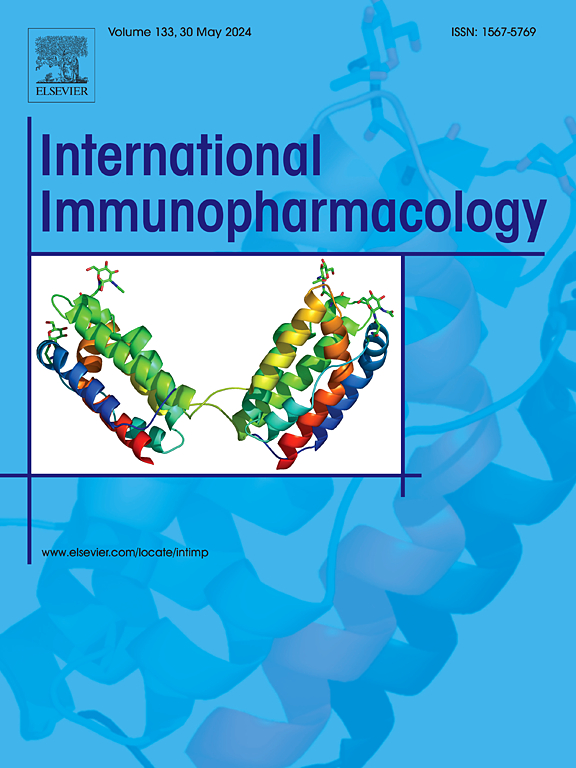在sifA缺陷沙门氏菌介导的3M2e-NP纳米颗粒疫苗上加入LTB佐剂,提高了鸡对H9N2禽流感病毒的保护作用
IF 4.7
2区 医学
Q2 IMMUNOLOGY
引用次数: 0
摘要
H9N2禽流感病毒由于其变异,仍然对家禽生产和公共卫生构成重大威胁。高度保守的胞外结构域、M2离子通道(M2e)和核蛋白(NP)通常被认为是广谱流感疫苗的潜在靶点。在这项研究中,我们使用缺乏sifA基因的调节延迟裂解沙门氏菌的x2 - 56作为递送载体,以三拷贝M2e (H9N2, H5N1和H1N1亚型,3M2e)和NP蛋白装饰的基于lumazine synthase (LS)的纳米颗粒疫苗,不含或含LTB佐剂,分别产生S311和S325。选取sifA基因缺失缺失的沙门氏菌亲本χ11802为对照,命名为311。动物实验表明,与BSG和空载体对照相比,口服S325可显著提高3M2e和NP特异性血清IgY、支气管肺泡IgA、气管IgA和肠道IgA抗体滴度。同时,sifA缺失和LTB佐剂的联合使用显著增强了脾脏淋巴细胞的增殖和细胞内IL-4和IFN-γ的产生,从而提高了对G57亚型H9N2病毒的保护作用,表现为体重增加,肺和气管病毒滴度降低,口咽和泄殖腔拭子中的病毒脱落减少。本文章由计算机程序翻译,如有差异,请以英文原文为准。
Improved protection against H9N2 avian influenza virus challenge in chickens by the presence of LTB adjuvant on the 3M2e-NP nanoparticle vaccine delivered by sifA deficient Salmonella
The H9N2 avian influenza virus is a still a great threat to poultry production and public health due to its variation. The highly conserved extracellular domain, M2 ion channel (M2e), and the nuclear protein (NP) are usually considered to be potential targets for a broad-spectrum influenza vaccine. In this study, we took use of a regulated delayed lysis Salmonella χYL56 lacking the sifA gene as a delivery vector to deliver a lumazine synthase (LS) based nanoparticle vaccine decorating with three copies of M2e (H9N2, H5N1 and H1N1 subtype, 3M2e) and NP protein, without or with LTB adjuvant, yielding S311 and S325, respectively. A parent Salmonella strain χ11802 without sifA gene deletion harboring 3M2e-NP plasmid was also included as a control and named 311. The animal study showed that oral immunization with S325 significantly increased the 3M2e- and NP- specific serum IgY, bronchoalveolar IgA, tracheal IgA and intestinal IgA antibody titers compared with BSG and empty vector control. Meanwhile, the combination of sifA deletion and LTB adjuvant dramatically enhanced the proliferation of spleen lymphocytes and intracellular production of IL-4 and IFN-γ, resulting in elevated protection against G57 subtype H9N2 virus, shown by increased body weight gains, decreased lung and tracheal virus titers, as well as decreased virus shedding in oropharyngeal and cloacal swabs.
求助全文
通过发布文献求助,成功后即可免费获取论文全文。
去求助
来源期刊
CiteScore
8.40
自引率
3.60%
发文量
935
审稿时长
53 days
期刊介绍:
International Immunopharmacology is the primary vehicle for the publication of original research papers pertinent to the overlapping areas of immunology, pharmacology, cytokine biology, immunotherapy, immunopathology and immunotoxicology. Review articles that encompass these subjects are also welcome.
The subject material appropriate for submission includes:
• Clinical studies employing immunotherapy of any type including the use of: bacterial and chemical agents; thymic hormones, interferon, lymphokines, etc., in transplantation and diseases such as cancer, immunodeficiency, chronic infection and allergic, inflammatory or autoimmune disorders.
• Studies on the mechanisms of action of these agents for specific parameters of immune competence as well as the overall clinical state.
• Pre-clinical animal studies and in vitro studies on mechanisms of action with immunopotentiators, immunomodulators, immunoadjuvants and other pharmacological agents active on cells participating in immune or allergic responses.
• Pharmacological compounds, microbial products and toxicological agents that affect the lymphoid system, and their mechanisms of action.
• Agents that activate genes or modify transcription and translation within the immune response.
• Substances activated, generated, or released through immunologic or related pathways that are pharmacologically active.
• Production, function and regulation of cytokines and their receptors.
• Classical pharmacological studies on the effects of chemokines and bioactive factors released during immunological reactions.

 求助内容:
求助内容: 应助结果提醒方式:
应助结果提醒方式:


